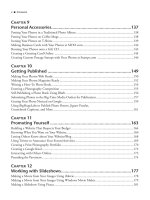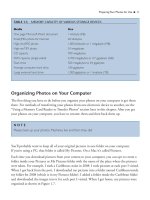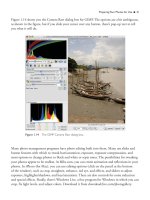101 QUICK AND EASY SECRETS FOR USING YOUR DIGITAL PHOTOGRAPHS- P13 pps
Bạn đang xem bản rút gọn của tài liệu. Xem và tải ngay bản đầy đủ của tài liệu tại đây (493.69 KB, 5 trang )
CHAPTER 3
Sharing Your Photos
with Family and
Friends
A
s the popularity of digital photography spreads, more and more people are
getting involved in sharing their photographs. Sharing photographs has
become an essential part not only of online digital photo hosting and social
networking sites, but also of more intimate settings, from social gatherings to family photo
websites. Photography has also become a way to make new friends. You can enroll in an
online photography class and work with others to improve your photography skills as you
share the photographs you have and new ones that you shoot.
Hosting Photo Nights to Share Photo Slideshows
If you’ve just gotten back from a great trip, what could be more fun than hosting a slideshow of
the pictures you took? It’s the perfect after-vacation activity.
You have to think about two things for your show to run smoothly—choosing a slideshow
program that you can easily use and knowing how to hook up your computer to your TV.
You can make a slideshow in many programs. Some of them are free, such as Picasa. To make
slideshows using some of these programs, go to Chapter 12, “Working with Slideshows.”
When you make a slideshow, there are programs that have options to save the show as a movie
file on a CD so you can burn copies for friends and family. Picasa is a good example of such a
slideshow program because it’s so easy to use. The program lets you play slideshows at the press
of a button. It also has a Movie Maker you can use to save your slideshows and even a button
that will create a movie and put it on YouTube for you. For specific directions on how to do
this, go to Chapter 12.
48 ■ Sharing Your Photos with Family and Friends
CONNECTING YOUR COMPUTER TO YOUR TV
It’s simple to connect an HDTV set to a PC. All you
need is a VGA adapter, a 15-pin connector on both
ends that you connect from your HDTV to your PC
(see Figure 3.1).To get the picture on the HDTV screen,
right-click on Graphics Options > Output to Monitor,
and you’re good to go.
It’s a slightly different story for a Mac.There have been
times when I’ve gone to speak at a convention armed
with my computer and a PowerPoint presentation, only
to find that I needed an adapter in order to hook up my
Mac to the TV. The cable that’s made to connect a TV to a computer is made for PCs.
Sometimes it just feels like a PC-based world. I learned a lesson,
though—I carry around a DVI-to-VGA adapter.While PCs have
VGA ports, Macs have DVI or mini-DVI ports, depending on the
model.The adapter (see Figure 3.2) is made to convert one end
of a VGA cable to connect to the DVI or mini-DVI port on a
Mac. Once you connect the DVI or mini-DVI end to your Mac
and the VGA to the HDTV set, your Mac will automatically
recognize what you’re doing and change your screen to
presentation mode so that you’re good to go.
Figure 3.1 The VGA cable allows
you to hook up your PC to a TV.
Figure 3.2 Use this adapter
to connect a Mac to an
HDTV set
There are a couple of slideshow programs that aren’t too expensive to buy that have many more
options than Picasa. There’s ProShow, which works with Windows, at www.photodex.com, and
Slideshow for Macs at www.apimac.com/downloads. Both programs allow you to save slideshows
as movie files so you can burn a CD/DVD and/or upload to YouTube. They also allow you to
add music, transition effects, and text.
Joining a Photography Meetup Group
Have you heard of Meetup groups? There are Meetup groups all over the country, like the one
shown in Figure 3.3. The purpose of these groups is to share similar interests with people in
your community. There are groups for hiking, scrapbooking, and, yes, photography. At the
time of this writing, there were 637 photography Meetup groups in 338 cities around the world.
It’s the way to get social in the new millennium.
Sharing Your Photos with Family and Friends ■ 49
Figure 3.3 The San Francisco Photography Meetup group has more than 1,500 members.
Here’s how it works: The person who starts a group, the organizer, pays a monthly fee to get the
group started. He or she then makes a webpage describing the group. Next, the organizer names
a date, time, and place where the group will meet and puts it up on the webpage for that group.
The Meetup group site gives a list of suggested meeting places as one of the prompts included
in the process of making the meeting announcement. When a person comes to the site (Google
is very good at listing these sites at the top tier of sites that it chooses to list for a number of
keywords related to photography), he or she can choose to register for the group and then make
a decision as to whether he/she will attend the meeting. There are generally yes, no, and maybe
choices for a “Will you be there?” prompt. Finally, the website keeps track and posts the number
of people who RSVPed. Only people who are registered can sign up for the meetups.
Registration is usually free.
At the meetings, participants share photos, go on shooting expeditions, and compare equipment.
People with all different kinds of photography skills attend, from fashion photographers to
those who shoot candidly. Finally, you don’t have to be a pro to attend. There are plenty of
beginners, too.
Taking an Online Photography Class
Another way to build an online community of photographers is to get together with others to
learn about photography. You can take online photography classes where you are taught by
some of the most skilled photographers in the industry. I think the two best schools (judging
by the experience of the instructors) are BetterPhoto.com and the Perfect Picture School of
Photography (www.ppsop.com). Many of the instructors are not only photographers; they are
also photography book authors. Here’s a summary of the two schools:
❈
BetterPhoto.com. BetterPhoto (see Figure 3.4) has more to offer than just classes; it offers
four tiers of membership, which gives you opportunities to build your own galleries (for the
Basic membership) and websites, with the ability to update quickly and easily for more elite
levels of membership. There are also opportunities to sell your photos on the site.
As far as courses are concerned, BetterPhoto offers four-week sessions once a month.
Dozens of courses range from classes on learning Photoshop basics to classes that are camera
model–specific (such as classes on the EOS Digital Rebels). They also offer eight-week
courses once every two months. Those classes include broader topics, such as fine art flower
photography and the business of photography.
50 ■ Sharing Your Photos with Family and Friends









